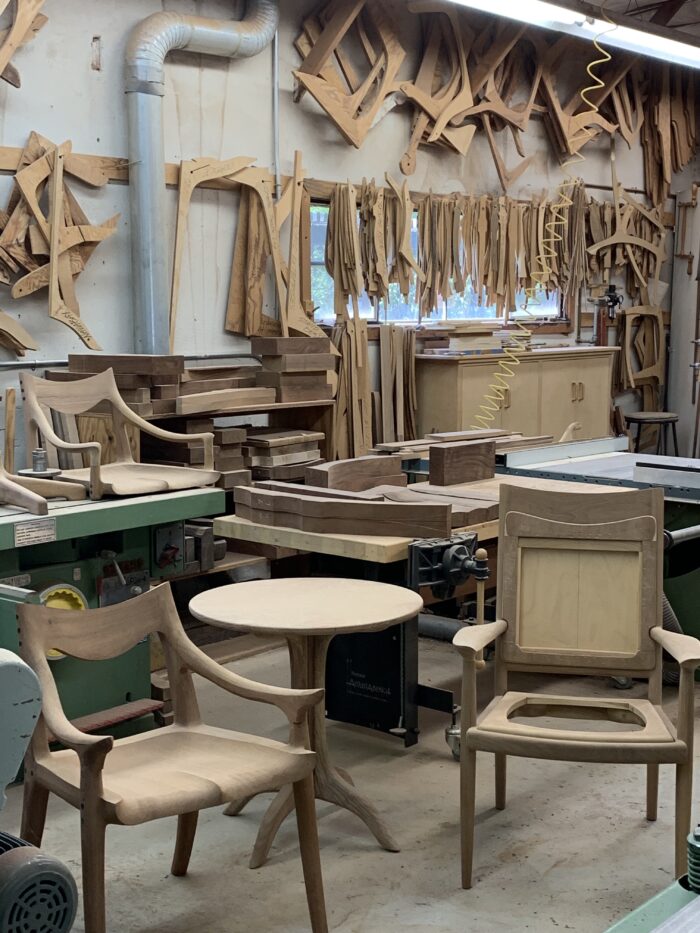Wood is the most beautiful, mind-boggling, and rewarding medium to work with, so how can we possibly achieve mastery in just one lifetime? Along with practice, taking classes, and reimagining and reworking our designs dozens of times, there is value in spending time outside the shop at woodworking destinations to fully explore the possibilities of creating with wood.
For my first-ever woodworking road trip, I toured the Sam Maloof compound, nestled at the foot of the San Gabriel mountains in Alta Loma in southern California.
The Sam and Alfreda Maloof Foundation was formed to perpetuate Sam’s legacy in crafts, and the foundation now operates his home as a public museum, runs a gallery, and maintains gardens for the public to enjoy. Also on the property is Sam Maloof Woodworker Inc., an active woodworking business in Sam’s original shop.
I have admired Maloof’s mid-century modern furniture design for years, but seeing it in person — interacting with and touching the famous Maloof finish (feels like butter) and interacting with his pieces — was a profound way to jump-start my design aesthetic.

Everything in Maloof’s home was meaningful and featured handcrafted details, like the spiral staircase he carved by hand. I reveled in the handcrafted gifts he made for his wife, including the stained glass bearing her name (Alfreda), a pulley system for her to lower and raise her plants, and a carved kitchen island for her spices.
I also appreciated Maloof’s eye for detail, which was evident in his hand-sculpted door latches. Door trims were joined by beveled dovetails and the window frames were mortise and tenon.
Another benefit of travel is getting out of your own head and learning from others. I was fortunate to connect with Mike Johnson, who is in his 42nd year as owner of Sam Maloof Woodworker Inc. As a master craftsman himself, he seemed like the perfect person to ask a question that’s often on my mind — where master craftspeople get their inspiration.
“It’s from this voice, Sam’s voice, that my inspiration comes,” Johnson told me. “I spent nearly 30 years working daily, side-by-side with him, and well, he talked a lot, and I tried my best to listen, even when I had heard some of the stories what seemed like a thousand times!”
As one example of how Maloof’s voice inspires him, Johnson mentioned several commissioned projects from the past few years that required replicating and updating chairs that Maloof had built for his clients. Years later, the clients are older and have bad knees, so the shop needed to increase the height of the seats — which is where Maloof’s voice came in.

“I hear Sam say, ‘Mike, it’s beginning to look a little leggy,’” Johnson said. “Translated, this means that the front legs are looking a little long for the rest of the proportions of the chair. I can thumb through woodworking magazines and see Maloof imitators’ work, who definitely did not hear Sam’s voice.”
Following my adventures at Maloof’s remarkable compound, I visited the George Nakashima complex in New Hope, Pa. There I met George’s daughter, Mira, who continues the family legacy along with her team of woodworkers at their busy studio. Mira worked under her father for 20 years, and, like her father, studied architecture, giving her a crash course in scale drawing, dimensioning, structure, design, and building.
While touring the lumber sheds with Mira, I brought up the struggle of labeling what we do with wood. George Nakashima blurred the lines between designer, woodworker, and artist, so which label did he give himself? Mira explained that he called himself a woodworker, raising the term to an honorable profession.

Touring the Nakashima grounds led to other, more practical insights. Back home, in my humble workshop, I used to store lumber on a wall rack with not much thought besides how best to get it off the ground to fit the cars in at night. That is, until I saw on the tour how they organize their lumber and their retrieval system for client selection. Lumber is “sawn in the boule” and stacked in the order sawn, a much more orderly method than my own.
On my way home, I visited Charles Holland, a logger in New Hill, N.C., who came recommended to me as a sawyer who specializes in live-edge slabs. He showed me how his sawmill works, and he gave me a great tip: If I want a slab with retained bark, I should choose wood cut during the dormant winter season. The bark peels more easily from summer-cut wood because the cambial layer is more fragile during the growing season.
Holland also gave me a tour of the smokehouse he built — from the doors to the floors. I learned how to cure a country ham that day, and he demonstrated his core borer that he fashioned out of spare parts. I gawked as he cored a bowl in 30 seconds out of a big block of wood.
My woodworking road trips have given me so much — including practical tips, new interests, and renewed awe for the masters. Whatever destinations you choose, similar experiences await that are sure to inspire your own fresh ideas.








